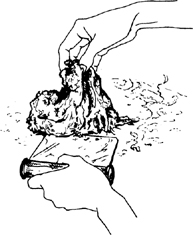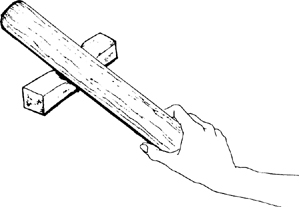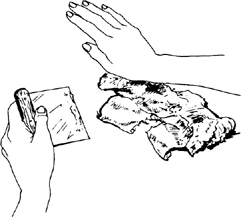Mastering the Art of French Cooking, Volume 2 (45 page)
Read Mastering the Art of French Cooking, Volume 2 Online
Authors: Julia Child

½ cake (0.3 ounce) fresh yeast or 1½ tsp dry-active yeast
3 Tb warm water (not over 100 degrees) in a measure
1 tsp sugar
Mix the yeast in the warm water with the sugar and let liquefy completely while measuring out the rest of the ingredients.
1¾ cups (about ½ lb. all-purpose flour measured by scooping dry-measure cups into flour and leveling off with straight-edged knife)
A 3- to 4-quart mixing bowl
2 tsp sugar
1½ tsp salt
⅔ cup milk warmed to tepid in a small saucepan
2 Tb tasteless salad oil
A rubber spatula
A pastry scraper or stiff metal spatula
Measure the flour into the mixing bowl. Dissolve the additional sugar and the salt in the tepid milk. When yeast has liquefied, pour it along with the milk mixture and oil into the flour. Blend the elements into a dough by cutting and pressing with the rubber spatula, being sure all bits of flour are gathered in. Turn dough out onto
kneading surface, scraping bowl clean. Let rest for 2 to 3 minutes while you wash and dry the bowl. The short rest allows flour to absorb liquid; dough will be quite soft and sticky.
| Start kneading by lifting near edge |
2)
The two rises
—
first about 3 hours
;
second about 1½ hours—at 70–72 degrees
The clean 3- to 4-quart mixing bowl
A large plastic bag or sheet of plastic
A bath towel
You will have about 2 cups of dough that is to rise to 3½ times its original volume, or to 7 cups. Fill bowl with 7 cups of tepid water, make a mark on the outside at the 7-cup mark to guide you. Pour out the water, dry the bowl, and put the dough into it.
Cover with plastic and bath towel, and place at a temperature of between 70 and 72 degrees. In 3 or 4 hours dough should have risen to the 7-cup mark, and will be light and springy when touched.
Deflate by loosening dough from edges of bowl with a rubber spatula or the cupped fingers of one hand, and turn it out onto a lightly floured surface. With the lightly floured palms of your hands, pat and push the dough out into a rectangle about 8 by 12 inches. Fold in three as though folding a business letter. Return dough to bowl; cover again with plastic and bath towel.
Let rise a second time, but only to double the original volume. Then loosen dough from edges of bowl and turn out onto a lightly floured plate. Cover airtight and refrigerate for 20 minutes, which will make the next step easier.
(*)
DELAYED ACTION
: Set dough in a colder place to rise, or let it rise the second time overnight in the refrigerator. After second rise, when dough has been turned out of bowl onto plate, you may
freeze it for a week
.
3)
Rolling in the butter; turns 1 and 2
4 to 7 ounces (1 to 1¾ sticks) chilled unsalted butter
A rolling pin (see
illustrated comments
)
Flour as needed
A pastry scraper
Waxed paper or plastic
A plastic bag
Butter is now to be softened and rolled in layers with the dough. If this is your first attempt, use the minimum quantity. During all the following operations, roll rapidly and keep the dough well chilled—warm, limp dough is impossible to work with!
| Butter must now be worked into a smooth but still cold paste that can be spread evenly on the dough and then rolled with it. |
Then smear it out with the heel of your hand or a scraper or spatula |
|





